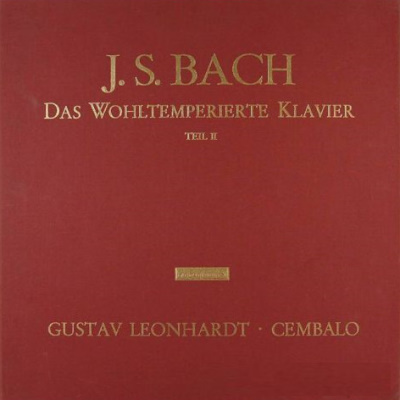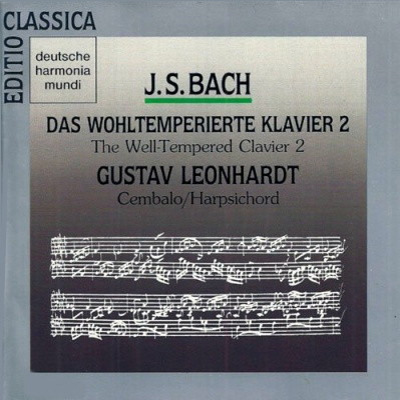 |
|
3 LPs
- HMS 30 850/52 - (p) 1968
|
 |
| 2 CDs -
GD 77012 - (c) 1989 |
|
| DAS
WOHLTEMPERIERTE KLAVIER - TEIL II |
|
|
|
|
|
|
|
| Johann Sebastian
BACH (1685-1750) |
24
Präludien und Fugen durch die Tonarten,
BWV 870-893 |
|
|
|
|
- I. D-dur
|
|
4' 15" |
A1 |
|
- II. c-moll |
|
4' 52" |
A2 |
|
- III.
Cis-dur |
|
4' 05" |
A3 |
|
- IV.
cis-moll
|
|
7' 25" |
A4 |
|
- V.
D-dur |
|
5' 25" |
B1 |
|
- VI. d-moll |
|
3' 33" |
B2 |
|
- VII.
Es-dur |
|
4' 37" |
B3 |
|
- VIII.
dis-moll
|
|
5' 50" |
B4 |
|
- IX.
E-dur |
|
6' 55" |
C1 |
|
- X. e-moll
|
|
5' 01" |
C2 |
|
- XI. F-dur |
|
5' 17" |
C3 |
|
- XII.
f-moll
|
|
5' 37" |
C4 |
|
-
XIII. Fis-dur |
|
6' 40" |
D1 |
|
-
XIV. fis-moll
|
|
7' 07" |
D2 |
|
-
XV. G-dur
|
|
3' 22" |
D3 |
|
-
XVI. g-moll
|
|
5' 10" |
D4 |
|
-
XVII. As-dur |
|
7' 25" |
E1 |
|
-
XVIII. gis-moll
|
|
7' 08" |
E2 |
|
-
XIX. A-dur
|
|
3' 55" |
E3 |
|
-
XX. a-moll
|
|
3' 52" |
E4 |
|
-
XXI. B-dur |
|
7' 53"
|
F1 |
|
- XXII.
b-moll
|
|
8' 26" |
F2 |
|
- XXIII.
H-dur
|
|
6' 25" |
F3 |
|
- XXIV.
h-moll
|
|
4' 33" |
F4 |
|
|
|
|
|
Gustav
Leonhardt, Cembalo (Martin
Skowroneck, Bremen 1962 nach einem
Instrument von J. D. Dulcken,
Antwerpen 1745)
|
|
|
|
|
|
Luogo
e data di registrazione |
|
Cedernsaal, Schloß
Kirchheim (Germany) - 1967
|
|
|
Registrazione: live
/ studio |
|
studio |
|
|
Recording
Supervision |
|
Dr. Alfred Krings |
Dr. Kurt Hahn
|
|
|
Engineer |
|
Hubert Kübler
|
|
|
Prima Edizione LP |
|
Harmonia Mundi | HMS
30 850/52 | 3 LPs - durata 37' 02"
- 45' 09" - 49' 33" | (p) 1968
|
|
|
Edizione CD |
|
Deutsche Harmonia
Mundi | LC 00761 | GD 77012 | 2
CDs - durata 63' 22" - 72' 40" |
(c) 1989 | ADD |
|
|
Cover Art
|
|
-
|
|
|
Note |
|
- |
|
|
|
|
In 1730, seven
years after he took on his
new duties as Cantor of St.
Thomas' in Leipzig, Johann
Sebastan Bach wrote to his
old friend Gerorg Erdmann in
hopes of obtaining a
position in Danzig. "I
find," he complained, "that
this appointment is by no
means so advantageous as it
was described to me, that
many fees incidental to it
are now stopped, that the
town is very deat to live
in, and that the authorities
are very strange folks, with
small love for music, so
that I live under almost
constant vexation, jealousy
and persecution..." The
outcome of the request was
negative.
Bach's difficulties did not
abate during the following
two decades, although the
next few years proved
relatively calm. His work
consisted principally of
training the Thomasschule
boys for their singing
duties in the town's main
churches, conducting the
choirs, playing the organ
for services and providing
the cantatas for Sundays. In
addition he had to teach
Latin to the boys, supply
music and performances for
funerals and civic occasions
and train the Leipzig
University Musical Sociaty.
On his own he added to his
income by testing out newly
constructed organs, and, of
course, he taught his own
pupils. Recent research has
shown that Bach's huge
output of cantatas,
comprising between three and
five (many are lost)
complete series for the
ecclesiastical year, were
largely produced before
1729. After that time work
consisted to a great extent
of adaptations of existing
material. That included, as
well, much of the music Bach
supplied for the students'
Collegium Musicum, an
organization that absorbed
the composer's interest from
1729 until the late 1730s.
For reasons that have not
yet benn ascertained, then,
Bach's extraordinary flow of
creativity dwindled
considerably during the last
two decades of his life. One
can only speculate as to the
cause. Assuredly he was as
happy directing the
Collegium Musicum as he was
frustrated with his school
and church duties. Between
1736-38 Bach became
embroiled in a controversy
with the new school rector
about a question of
authority over the students,
and while this was in
progress he was the subject
of a scalthing written
criticism by a former pupil.
He was eventually vindicated
in the school matter by the
intercession of the ruler of
Saxony, and his pupils
stoutly defended him in
print over the charge that
his music was "turgid and
confusinf." In 1735 the
second part of his Clavierübung
(the Italian Concerto and
the French Overture) had
been published; four years
later part three (the German
organ mass) was printed and
in 1742 part four, the
"Goldberg" Variations.
Assembling his works,
organizing, revising and
gathering them into larger
units seems to have begun to
preoccupy Bach during these
years. Also out of them we
have a second volume of
preludes and fugues in all
tonalities, a grouping not
specifically entitled The
Well-Tempered Clavier
by the composer but
obviously intended to be a
sequel to the work he had
compiled in Cöthen in 1722.
Equal temperament-that is,
the system of tuning in
which the octave is divided
into 12 equal-parts - was
advocated as early as 1636
by Marin Mersenne.
Conservatism, however, held
out for another 50 years in
favor of a number of older
tuning systems, of which
mean-tone temperament (the
interval of a third being
divided into two equal whole
steps) was one of the most
favored. Mean-tone tuning,
with its narrowed fifths and
absolutely pure thirds,
provided considerable color
but caused pieces written in
more than three sharps or
two flats to sound terribly
sour. Andreas Werckmeister
began the push toward equal
temperament in 1691 with a
treatise, which was
followed, over the next 30
years, by Johann David
Heinichen's 1711
thoroughbass method, Johann
Mattheson's 1719 Organistenprobe
and, in 1722, Friedrich
Suppig's Labyrinthus
Musicus (published)
and Johann Sebastian Bach's
Das Wohltemperierte
Klavier (unpublished).
Aside from theoretical
treatises, Bach undoubtedly
had also been influenced by
a number of other composers
who went beyond the usual
range of key signatures in
their works - Froberger,
Pachelbel and J. K. F.
Fischer, among others. The
Well-Tempered Clavier,
though it was distributed
only by hand copies, made
quite an impact in the years
following 1722. Pupils
cherished the first
collection of 24 preludes
and fugues, and one admirer,
Georg Andreas Sorge, an
organist at Lobenstein,
produced a similar volume in
1738. Yet equal temperament
did not immediately take
hold everywhere. Heinichen
mentions in 1728 that one
seldom finds music written
in B and A-flat and
practically never in F-Sharp
and C-Sharp. We also know
that Bach regularly twitted
the renowned instrument
builder Gottfried Silbermann
about the way in which he
tuned his organs: "You tune
the organ in the manner you
please, and I play
the organ in the jey I
please"; Bach then proceeded
to toss off a piece in the
key of A-flat, whose
excruciantingly sour
accidentals generally caused
Silbermann to leave the
church in embarrassment.
Although 1744 is usually
given as the completion date
for Bach's second collection
of 24 preludes and fugues
(this date is given in one
of the copies made by his
pupil Johann Altnikol), it
is possible that the work
may have been finished as
early as 1740. It is
doubtful whether it was
intended for publication,
the expense being too great
and the possibility of sales
limited; in any case, part
of Bach's method of teaching
invariably involved the
copying of his manuscripts
by pupils, and this is how
much of his music has come
down to us today. Bach would
also make copies for his
various pupils, sometimes
altering the text, revising
and improving, so that many
of the preludes and fugues
of Book 2 have a
considerable number of
variants. Nor did Bach
simply sit down to write a
second collection; as with
so many of his cantatas ans
instrumental works from
these years, he often used
existing material, sometimes
adding embellishments,
changing rhythmic
figurations and making more
extensive movements out of
shorter ones.
The Prelude and Fugue in C,
for instance, exists in
three versions for each
section; the earliest of
these preludes can be dated
back to 1725. Prelude No. 3
in C-sharp was revised and
expanded from a C major
original. The C-sharp minor
Fugue, likewise, was first
in C minor. Two previous
versions exist for the D
minor prelude, and for the
Fugue No. 17 in A-Flat Bach
adapted and enlarged a
Fughetta in F. Finally, the
Prelude and Fufue No. 15 in
G has among several sources
a prelude from one prelude
and fughetta and the fugue
from another.
Overall, in comparison with
the first book of The
Well-Tempered Clavier,
Book 2 has a greater variety
of preludes in different
forms. Fully 10 (as against
only one in Book 1) are
binary movements with
repeats; there are dances
(for instance, No. 8, an
allemande), inventions (No.
10, a two-part; No. 19, a
three-part), ariosos (Nos. 4
and 14) and concerto
movements (Nos. 13 and 23).
The fugues in general are
also looser in form, more
artistically conceived and
often more involved with
double counterpoint,
although Bach allowed
himself considerable freedom
on occasion in matters of
adding interludes and
increasing the number of
parts. Fifteen of the fugues
are in three voices, nine of
them in four (Book 1: one
two-voice, 11 three-voice,
10 four-voice, and two
five-voice). Moreover, those
in C-sharp minor, A-flat,
G-sharp minor and B are
double fugues (that is, with
two subjects rather than
one), with No. 14 in F-sharp
minor being a triple fugue.
The rhythmic pattern of the
gigue may be found in the
fugues in C-sharp minor, F,
G, G-sharp minor and B
minor, and so far as
thematic relationship
between preludes and fugues
is concerned, it is most
readily apparent only in
those in C minor, G-sharp
minor, A, A minor, B-flat
and B-flat minor.
The Well-Tempered Clavier
circulated in handwritten
copies until the end of the
18th century, when both
English and German
publishers made plans to
print it. Bach's own
autograph did not turn up
until 1896, having been
owned by the daughter of the
late-18th-century British
Bach enthusiast Samuel
Wesley and before her, by
Muzio Clementi.
Igor
Kipnis
(Victrola
VICS-6125)
|
  |
|
|